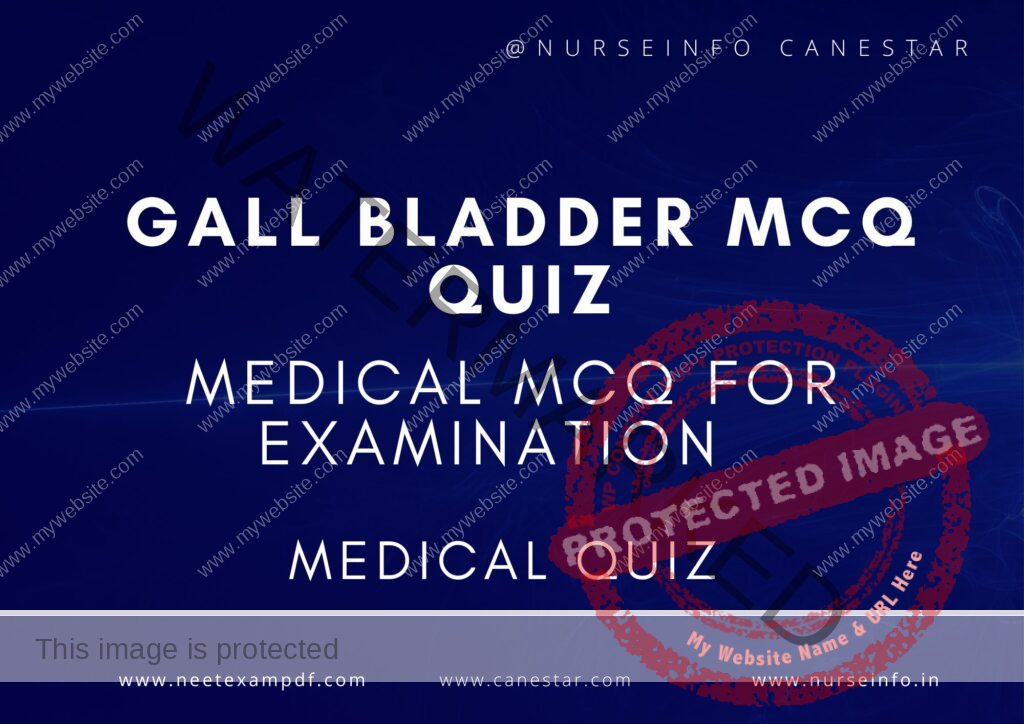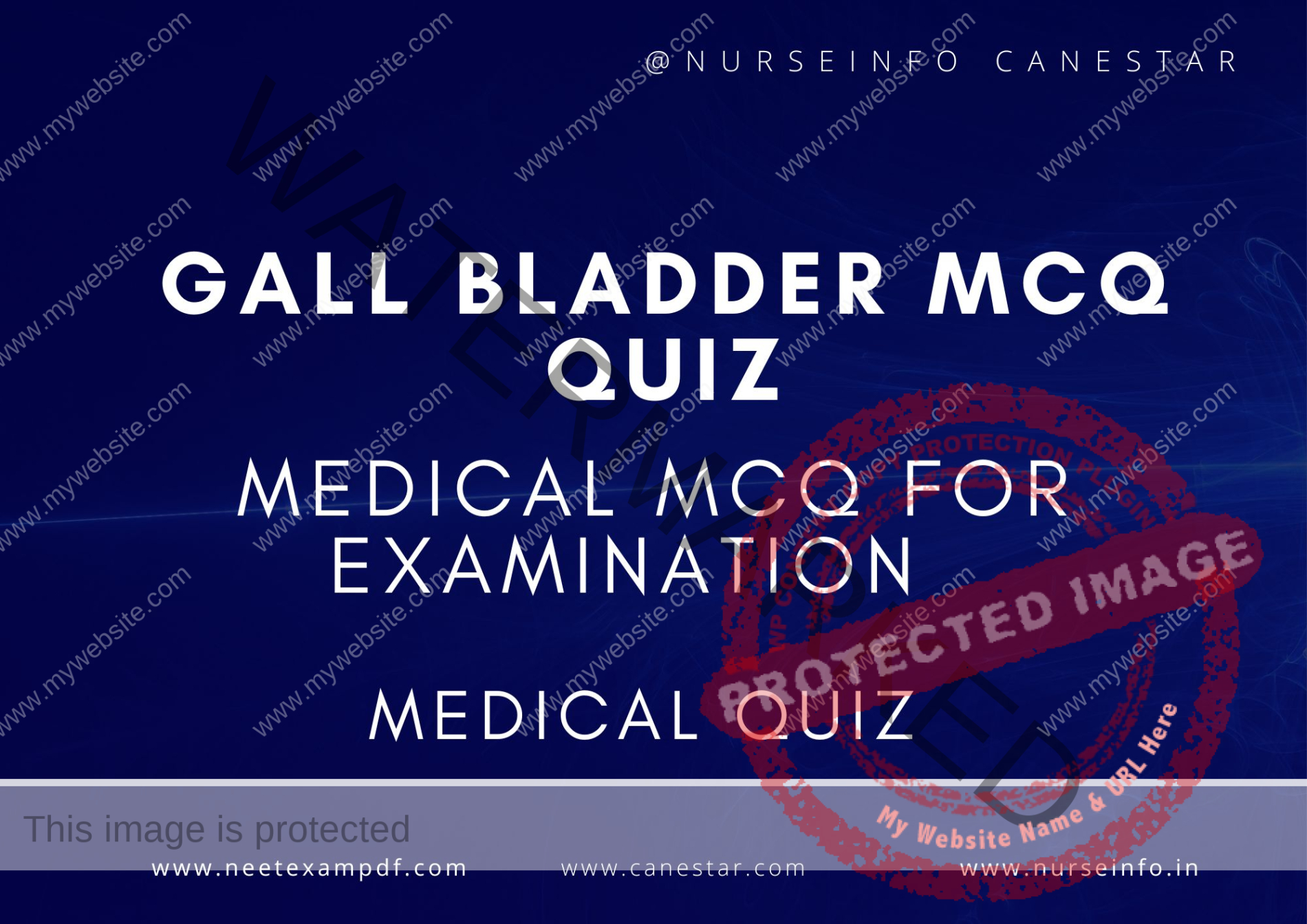MULTIPLE CHOICE QUESTIONS ON GALL BLADDER DISEASE QUIZ – MCQS WITH RATIONALE ANSWER – GALL BLADDER DISEASE MCQ QUESTIONS WITH RATIONALE
MCQ FOR GALL BLADDER DISEASE INCLUDING including Diagnosis, Symptoms, Treatment, and Complications QUIZ
These mcqs are prepared exclusively for medical professionals for exam preparation. MCQ is helpful to remember the concept on gall bladder disease mcq quiz. This multiple choice questions are helpful for preparation for DHA, PROMETRIC, MOH, HAAD, NCLEX, Medical, NEET and Nursing EXAMINATION
GALL BLADDER DISEASE MCQ: Gallbladder Disease, including Diagnosis, Symptoms, Treatment, and Complications
Gall Bladder MCQs with Rationale
1. Which of the following is the most common cause of cholecystitis?
A. Gallstones
B. Biliary atresia
C. Gallbladder polyps
D. Pancreatitis
Answer: A. Gallstones
Rationale: Gallstones are the most common cause of cholecystitis, leading to inflammation of the gallbladder when stones obstruct the cystic duct.
2. A positive Murphy’s sign is indicative of:
A. Pancreatitis
B. Appendicitis
C. Cholecystitis
D. Gastritis
Answer: C. Cholecystitis
Rationale: Murphy’s sign is a clinical test where the patient experiences pain upon palpation of the right upper quadrant during inspiration, indicating cholecystitis.
3. What is the most common symptom of gallbladder disease?
A. Diarrhea
B. Jaundice
C. Right upper quadrant pain
D. Nausea
Answer: C. Right upper quadrant pain
Rationale: Right upper quadrant pain is the most common symptom of gallbladder disease, often associated with meals and fatty foods.
4. The preferred imaging modality for diagnosing gallstones is:
A. MRI
B. CT scan
C. Ultrasound
D. X-ray
Answer: C. Ultrasound
Rationale: Ultrasound is the preferred imaging modality for diagnosing gallstones due to its high sensitivity, non-invasiveness, and lack of radiation exposure.
5. In the context of gallbladder disease, what does the term “biliary colic” refer to?
A. Inflammation of the gallbladder
B. Severe abdominal pain due to gallstone blockage
C. Chronic liver disease
D. Gallbladder cancer
Answer: B. Severe abdominal pain due to gallstone blockage
Rationale: Biliary colic refers to severe abdominal pain caused by the temporary blockage of the cystic duct by a gallstone, usually after eating a fatty meal.
6. Which of the following laboratory tests is most likely to be elevated in a patient with acute cholecystitis?
A. Serum amylase
B. Serum lipase
C. Serum bilirubin
D. Serum alkaline phosphatase
Answer: D. Serum alkaline phosphatase
Rationale: Elevated serum alkaline phosphatase is commonly seen in acute cholecystitis due to biliary obstruction and inflammation.
7. What is the initial treatment for a patient with suspected acute cholecystitis?
A. Surgical removal of the gallbladder
B. Antibiotics and supportive care
C. Liver transplant
D. Chemotherapy
Answer: B. Antibiotics and supportive care
Rationale: Initial treatment for acute cholecystitis involves antibiotics to treat infection and supportive care to manage symptoms, followed by possible surgical intervention.
8. Which of the following complications is associated with untreated cholecystitis?
A. Pancreatitis
B. Gallbladder perforation
C. Liver cirrhosis
D. Kidney failure
Answer: B. Gallbladder perforation
Rationale: Untreated cholecystitis can lead to complications such as gallbladder perforation, which can cause peritonitis and sepsis.
9. Which of the following is a common risk factor for gallstone formation?
A. High-fiber diet
B. Obesity
C. Low cholesterol levels
D. Chronic kidney disease
Answer: B. Obesity
Rationale: Obesity is a common risk factor for gallstone formation due to increased cholesterol levels in bile, which can precipitate stone formation.
10. What is the typical management of asymptomatic gallstones?
A. Immediate surgery
B. Watchful waiting
C. Chemotherapy
D. Radiation therapy
Answer: B. Watchful waiting
Rationale: Asymptomatic gallstones are typically managed with watchful waiting since they often do not cause problems and surgery carries risks.
11. Which of the following findings on an ultrasound would suggest acute cholecystitis?
A. Gallbladder polyps
B. Thickened gallbladder wall
C. Enlarged common bile duct
D. Normal gallbladder size
Answer: B. Thickened gallbladder wall
Rationale: A thickened gallbladder wall on ultrasound is a common finding in acute cholecystitis, indicating inflammation.
12. What is the primary function of the gallbladder?
A. Producing bile
B. Storing bile
C. Metabolizing fats
D. Detoxifying blood
Answer: B. Storing bile
Rationale: The primary function of the gallbladder is to store and concentrate bile produced by the liver, releasing it into the small intestine during digestion.
13. Which of the following symptoms would most likely indicate choledocholithiasis (gallstones in the common bile duct)?
A. Hematemesis
B. Steatorrhea
C. Jaundice
D. Hematuria
Answer: C. Jaundice
Rationale: Jaundice, or yellowing of the skin and eyes, occurs in choledocholithiasis due to obstruction of bile flow and subsequent buildup of bilirubin in the blood.
14. In which of the following populations are gallstones most commonly found?
A. Children
B. Men aged 20-30
C. Women aged 40-50
D. Elderly men
Answer: C. Women aged 40-50
Rationale: Gallstones are most commonly found in women aged 40-50, especially those with risk factors such as obesity, pregnancy, and certain hormonal factors.
15. A patient presents with fever, right upper quadrant pain, and jaundice. What is the most likely diagnosis?
A. Hepatitis
B. Cholecystitis
C. Cholangitis
D. Pancreatitis
Answer: C. Cholangitis
Rationale: Fever, right upper quadrant pain, and jaundice (Charcot’s triad) are classic signs of cholangitis, an infection of the bile ducts.
16. What is the gold standard for diagnosing choledocholithiasis?
A. MRI
B. Endoscopic retrograde cholangiopancreatography (ERCP)
C. CT scan
D. Abdominal X-ray
Answer: B. Endoscopic retrograde cholangiopancreatography (ERCP)
Rationale: ERCP is the gold standard for diagnosing choledocholithiasis as it allows for direct visualization and possible removal of stones from the common bile duct.
17. Which of the following is not a typical symptom of gallbladder disease?
A. Right upper quadrant pain
B. Vomiting
C. Fever
D. Hematuria
Answer: D. Hematuria
Rationale: Hematuria (blood in urine) is not a typical symptom of gallbladder disease, which usually presents with right upper quadrant pain, vomiting, and fever.
18. Which of the following dietary recommendations is appropriate for a patient with gallbladder disease?
A. High-fat diet
B. Low-fat diet
C. High-carbohydrate diet
D. High-protein diet
Answer: B. Low-fat diet
Rationale: A low-fat diet is recommended for patients with gallbladder disease to reduce the workload on the gallbladder and prevent exacerbation of symptoms.
19. Which of the following is a potential complication of gallbladder surgery (cholecystectomy)?
A. Chronic kidney disease
B. Postcholecystectomy syndrome
C. Liver cirrhosis
D. Peptic ulcer disease
Answer: B. Postcholecystectomy syndrome
Rationale: Postcholecystectomy syndrome is a potential complication of gallbladder surgery, characterized by persistent symptoms such as abdominal pain and dyspepsia.
20. Which of the following medications is used to dissolve cholesterol gallstones?
A. Metformin
B. Ursodeoxycholic acid
C. Omeprazole
D. Atorvastatin
Answer: B. Ursodeoxycholic acid
Rationale: Ursodeoxycholic acid is used to dissolve cholesterol gallstones by reducing the cholesterol content of bile, making it less likely for stones to form


